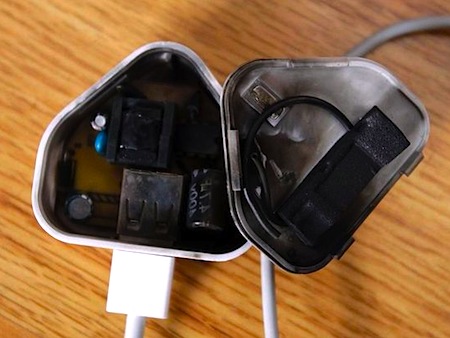Take care, there are many fake mobile phone chargers around – and they can kill!
Reports have been pouring in about the risks posed by the fast increasing numbers of counterfeit or poor quality mobile device chargers that are finding their way onto the British market. By James Hunt:
Mobile phones and tablets are today considered to be absolutely essential – not only for pleasure and social reasons, but for business too. It’s hard to fake a mobile device like these while maintaining full functionality, but the chargers are different. More and more fake and poor quality – and frankly often dangerous mobile device chargers are finding their way onto the UK market – many of them acquired on-line.
As Electrical Safety First says, ‘around 1.8 million chargers are bought online each year in the UK by mobile phone owners in search of a bargain. Though it’s often cheaper to buy imported, unofficial chargers, the cost can be much greater in the long run.’
Counterfeit chargers, which are many of those bought on-line, are often made with poor quality components that fail to meet UK safety regulations, so they can cause injury, electric shocks and fires. As an example, Will Best, MD of Pat Labels Online (
www.patlabelsonline.co.uk), which has been supplying electrical safety labels to engineers, contractors and wholesalers in the UK since 2002, has noticed some worrying trends throughout 2014, with an increase in what he classes as ‘dangerous goods’ flooding the UK market from overseas.
He said: “Contacts and colleagues in the industry are all reporting the increased presence of dangerous goods in the UK marketplace, ranging from cheaply manufactured electronic cigarette chargers which can spontaneously blow up, to imitation children’s toys which can cause electric shocks… this surge is undoubtedly putting lives and homes at risk’.
Will continued: “In my opinion, it is the dangerous and unregulated production of counterfeit phone and tablet chargers which present the biggest risk to the consumer. Although genuine chargers are seen as expensive, a price cannot be put on safety.”
Dangerous and not at all like the real thing
Will Best pointed out that London Fire Brigade investigation units carried out a range of tests on counterfeit chargers and reported that those using fake devices are ‘risking electrocution, burns or even a serious house fire’.
The report also stated that ‘the two genuine Apple iPhone chargers analysed by investigators had 60 or more components in their circuitry, while the sub-standard or counterfeit chargers had, on average, less than half that number’. This fact alone should be a safety and performance concern.
Explosive potential
In a recent example, South Tyneside residents have been warned about the dangers of using poor quality or fake look-a-like mobile phone chargers after a number of incidents in the area. South Tyneside's Trading Standards team has been investigating several complaints from people about cheap replacement chargers starting to smoke or causing electric shocks. In some cases, chargers have even exploded.
Commented Councillor Tracey Dixon, Lead Member for Area Management and Community Safety at South Tyneside Council: "While we have been very lucky that there have been no fires or injuries reported to us caused by low quality chargers in South Tyneside, in other parts of the country, it is thought that fake or poor quality chargers have been responsible for starting house fires.
"These replacement chargers are generally bought very cheaply over the Internet or at smaller electrical stores but they are more likely to be a safety hazard and could easily damage people's mobile phones or much worse.
"We appreciate that it can be difficult to tell the difference between the genuine article and a fake, other than by comparing price and quality, but we would strongly recommend residents to buy the authentic products made by the maker of the phone or from reputable suppliers.”
This is strongly echoed by Will Best, who said that first and foremost, buy chargers from reputable dealers, but that those people who believe they have been the victims of counterfeit goods, should do the following:
- Contact Trading Standards for advice
- If the seller is based in the EU, you have 14 days within which you can return the item for any reason and get your money back
- If an item is faulty or mis-described, you have the right to have a full refund, including any postage costs - although this can be challenging if the trader is based outside the EU
- Do not use the product.
Advice for consumers
It is recommended that a three-point safety check be carried out when buying a plug-in charger:
- Plug pins - Check the charger plugs in easily into the socket but don't switch it on or connect to the mobile phone. If it doesn't fit, then the pins may be the wrong size or the distance between the pins may be wrong, which could be dangerous.
- Markings - Look out for a manufacturer's brand name or logo, model and batch number. Check for a CE mark and that the output voltage and current ratings marked on the charger and phone are the same. Don't rely on the CE mark alone as they can be easily forged.
- Warnings and instructions - Adequate warnings and instructions must be provided. As a minimum, user instructions should provide information on conditions and limitations of use, how to operate the charger safely, basic electrical safety guidance and how to dispose of the charger safely.
For much more information on chargers for specific mobile phones, go to Electrical Safety First’s ‘3-point safety check’ at: www.electricalsafetyfirst.org.uk/guides-and-advice/electrical-items/chargers/
Those who feel that they may have bought a fake or dangerous charger should contact Trading Standards through the Citizens Advice Consumer Service on 08454 040506
 08454 040506
08454 040506. To learn more about electrical product counterfeiting generally, and what is being done to counteract it, plaese go to 'Counterfeit Kills', the BEAMA owned and Voltimum driven web portal at:
www.counterfeit-kills.co.uk/uk/index.php
Read others news
